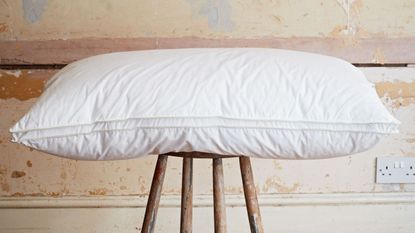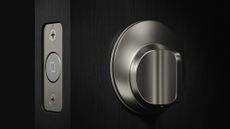
When you're deciding on a new pillow, one main decision you're going to face early on is what stuffing to go for. Traditional down or feathers? Memory foam? Synthetic stuffing? All of these have their pros and cons, and all are represented in our best pillow ranking. But which one is right for you will depend on your own particular sleep needs and preferences.
In this comparison guide, we explain what the different pillow types feel to lie on in practice, and outline the pros and cons of each. For more guidance, make sure to also look at our pillow size guide.
Down pillows: pros and cons
Down is made from a goose or duck’s finest feathers, which are found underneath the tougher, exterior feathers on the bird. The best quality down is Hungarian goose down or European white goose down. That said, do check the label. Most so-called ‘down’ pillows are actually filled with a mixture of down and ordinary feathers, which means they're cheaper but lower quality overall.
Down pillows are more expensive than synthetic pillows, but they also last much longer; potentially for several years if you take care of them. So they may actually save you money over time.
Get a good quality one, and down pillows are soft, plush, and typically very comfortable. They are lightweight with a high loft and hold their shape over time, although they'll benefit from regular plumping. From an environmental perspective, they're a renewable and sustainable resource, although do check to make sure yours are coming from an ethically sound source.
So what are the downsides of down? It might not be a great option is you tend to sleep hot at night, as this kind of filling tends to trap heat and reflect it back at the sleeper. Also, because they’re soft, they don’t provide as much support as, say, a memory foam pillow, and they'll change shape overnight, too. If you suffer back, neck or joint problems, you might benefit from the more uniform support of a foam pillow.
Feather pillows: pros and cons
Pillows filled with ordinary feathers are a cheaper alternative to down pillows. They’re also a better option for those who sleep hot, as they tend to stay cooler than down pillows. However, if you can afford to buy another type of pillow, we’d recommend making the investment, as feather pillows tend to lose their shape and become flat and uncomfortable quite quickly.
Upgrade to smarter living
Get the latest news, reviews, deals and buying guides on gorgeous tech, home and active products straight to your inbox.
Synthetic pillows: pros and cons
Synthetic pillows, typically filled with polyester stuffing, are the most common type of pillow. They're generally cheaper than down, as well as being firmer. Many can be machine-washed (here's how to clean a pillow if you're unsure), which means they can be a more practical option for allergy sufferers. The downsides here are that if you go for a cheaper synthetic pillow, it'll likely become flat and lumpy over time, which means they can prove to be a false economy. Some can also trap body heat.
That said, there are some notable exceptions. Head to our Soak&Sleep Supremely Soft As Down pillow review and Emma Premium Microfibre Pillow review for two options that we rate highly.
Memory foam pillows: pros and cons
Memory foam pillows adjust to your specific shape, keeping your head and neck in place all night, and helping you to maintain spinal alignment. They're a great choice, then, for anyone who suffers neck and shoulder pain, because they'll provide consistent support all night, no matter how much you wriggle about. They're also very durable and less likely to change shape, or go flat over time, than most feather and synthetic pillows.
In this market you'll a variety of different types of foam. What we think of as 'true' memory foam has a slight quicksand feel – you'll sink in slightly and they'll take a second to spring back when pressure is removed. Some people love this sensation; others do not. For an example of this type, head to our Panda pillow review.
Other foam pillows spring back immediately when pressure is removed. We're big fans of this type of pillow – check out our REM-Fit 500 Cool Gel pillow review and Levitex pillow review for two brands we particularly rate (the latter is available in different depths).
As well as pillows that include big blocks of foam, you'll find options that include cubes or shredded foam. These look and feel more similar to a traditional pillows, and still to some extent mould to your head and neck shape, but won't provide quite as consistent support as a block of foam would. Our Simba Hybrid Pillow review will give you an overview of that type.
So what are the potential down-sides of foam pillows? Cheaper memory foam can be notorious for trapping body heat, so be aware of that. Some can also have an unpleasant chemical smell when first unboxed. And finally, pillows that contain a block of foam just don't look that appealing in a pillow case.
Latex pillows: pros and cons
Finally, a bit of a wild card: latex. Latex is a natural material originally made from the sap of the rubber tree, although synthetic versions are increasingly common. Latex pillows have the advantage of lasting even longer than memory foam. They're also chemical-free, naturally antifungal and hypoallergenic.
Latex has similar properties to memory foam, in that it moulds to the neck and head, but in less of a rigid way than the latter. Overall, latex is bouncier and softer than memory foam, which may be a pro or a con depending how much support and contouring you want from your pillow. Latex is also better at staying cool than memory foam.
On the downside, latex pillows do tend to have an unpleasant smell initially, although this will fade over time. They’re also usually more expensive, and of course, are not an option if you have a latex allergy.
Tom May is a freelance writer and author of the book, Great Ted Talks: Creativity. He has been editor of Professional Photography magazine, associate editor at Creative Bloq, and deputy editor at net magazine. He has also worked for a wide range of mainstream titles including Radio Times, NME, Heat, Company and Bella.
- Bethan Girdler-MaslenHome Editor
-
 Forget the treadmill – this bodyweight bench workout is the perfect calorie crusher
Forget the treadmill – this bodyweight bench workout is the perfect calorie crusherIt's short and sweet, but very sweaty
By Bryony Firth-Bernard Published
-
 I've never been too fussed about smart locks, but this tiny model has changed my mind
I've never been too fussed about smart locks, but this tiny model has changed my mindThe Level Lock+ (Matter) is seriously impressive
By Lizzie Wilmot Published
-
 Oura expert reveals 4 tips to manage stress for International Stress Awareness Week
Oura expert reveals 4 tips to manage stress for International Stress Awareness WeekOura reveals how to manage your stress levels and why not all stress is bad
By Bethan Girdler-Maslen Published
-
 Nutritionist reveals top 5 foods you should eat to fight the winter blues
Nutritionist reveals top 5 foods you should eat to fight the winter bluesHow many of these are included in your diet?
By Lizzie Wilmot Published
-
 7 tips to help you sleep with a blocked nose
7 tips to help you sleep with a blocked noseTackle the cold and flu season with these helpful sleep tips
By Bethan Girdler-Maslen Published
-
 Amazon could be making its own smart pillow to combat sleep apnea – but I’m not convinced
Amazon could be making its own smart pillow to combat sleep apnea – but I’m not convincedAmazon files a patent to make its very own smart pillow
By Bethan Girdler-Maslen Published
-
 This Dyson desk light tracks local daylight and reacts to your surroundings – but it’ll cost you
This Dyson desk light tracks local daylight and reacts to your surroundings – but it’ll cost youThe Dyson Solarcycle Morph adds extra daylight to your routine
By Bethan Girdler-Maslen Published
-
 7 tips for keeping your home warm without turning the heating on, according to experts
7 tips for keeping your home warm without turning the heating on, according to expertsAvoid turning on the heating while keeping your home warm with these expert-approved tips
By Bethan Girdler-Maslen Published
-
 Protein Works expands its wellness lineup with two collagen-infused drinks
Protein Works expands its wellness lineup with two collagen-infused drinksBoth drinks are currently 10% off on the website
By Lizzie Wilmot Published
-
 These Ozlo sleep earbuds have a built-in alarm and audio masking – but they’ll cost you
These Ozlo sleep earbuds have a built-in alarm and audio masking – but they’ll cost youThe brains behind Bose have debuted the most advanced sleep earbuds
By Bethan Girdler-Maslen Published
